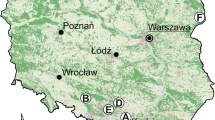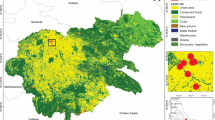Abstract
Domestic cats Felis catus, as companion animals provided with supplemental food, are not limited by the availability of wild prey and locally occur at extraordinary high densities. There is growing concern about the potential impact of large cat numbers on native prey populations. In the present study, we quantified the minimum number of animals killed in a rural village in Switzerland by asking owners (1) to estimate the predation rate in advance and (2) to record prey animals returned home by their pets. The frequency distribution of the numbers of prey items was markedly skewed: 16% of the cats accounted for 75% of prey, irrespective of sex, age or breed. A large fraction of owners considerably overestimated their cat’s predation, indicating that surveying predation rates by means of a questionnaire alone is not sufficient. The observed average rate of predation within 48 days in spring was 2.29 prey items/cat/month (N = 32 cats); major prey types were rodents (76.1%) and birds (11.1%). The absolute number of prey items taken per area is striking and indicates that cat predation represents an important factor in ecosystems. Its role may be momentous in intensively fragmented urban habitats, where cat densities are especially high. We thus highlight the need to identify the factors determining predation rates of individual cats. Further extended studies, especially in urbanised areas, are needed to quantify the actual impact of cat predation upon the population dynamics of their prey.

Similar content being viewed by others
References
Baker PJ, Ansell RJ, Dodds PAA, Webber CE, Harris S (2003) Factors affecting the distribution of small mammals in an urban area. Mamm Rev 33:95–100
Baker PJ, Bentley AJ, Ansell RJ, Harris S (2005) Impact of predation by domestic cats Felis catus in an urban area. Mamm Rev 35:302–12
Baker PJ, Molony SE, Stone E, Cuthill IC, Harris S (2008) Cats about town: is predation by free-ranging pet cats Felis catus likely to affect urban bird populations? Ibis 150(suppl1):86–99
Barratt DG (1997) Predation by house cats, Felis catus (L.), in Canberra, Australia. I. Prey composition and preference. Wildl Res 24:263–77
Barratt DG (1998) Predation by house cats, Felis catus (L.), in Canberra, Australia. II. Factors affecting the amount of prey caught and estimates of the impact on wildlife. Wildl Res 25:475–87
Beckerman AP, Boots M, Gaston KJ (2007) Urban bird declines and the fear of cats. Anim Conserv 10:320–5
Borkenhagen P (1978) Von Hauskatzen (Felis sylvestris f. catus L., 1758) eingetragene Beute. Z Jagdwiss 24:27–33
Burkhardt M, Schmid H (2001) Vögel in der Schweiz. Schweizerische Vogelwarte, Sempach
Calver M, Thomas S, Bradley S, McCutcheon H (2007) Reducing the rate of predation on wildlife by pet cats: the efficacy and practicability of collar-mounted pounce protectors. Biol Conserv 137:341–8
Campos CB, Esteves CF, Ferraz K, Crawshaw PG, Verdade LM (2007) Diet of free-ranging cats and dogs in a suburban and rural environment, south-eastern Brazil. J Zool 273:14–20
Carss DN (1995) Prey brought home by two domestic cats (Felis catus) in northern Scotland. J Zool 237:678–86
Churcher PB, Lawton JH (1987) Predation by domestic cats in an English village. J Zool 212:439–55
Dickman C (1996) Overview of the impacts of feral cats on Australian native fauna. Report for the Australian Nature Conservation Agency, University of Sydney
Fitzgerald BM, Turner DC (2000) Hunting behaviour of domestic cats and their impact on prey populations. In: Turner DC, Bateson P (eds) The domestic cat: the biology of its behaviour, 2nd edn. Cambridge University Press, Cambridge, pp 148–71
Flux JEC (2007) Seventeen years of predation by one suburban cat in New Zealand. New Zeal J Zool 34:289–96
Gillies C, Clout M (2003) The prey of domestic cats (Felis catus) in two suburbs of Auckland City, New Zealand. J Zool 259:309–15
Hughes BJ, Martin GR, Reynolds SJ (2008) Cats and seabirds: effects of feral domestic cat Felis silvestris catus eradication on the population of sooty terns Onychoprion fuscata on Ascension Island, South Atlantic. Ibis 150(suppl1):122–31
Kays RW, DeWan AA (2004) Ecological impact of inside/outside house cats around a suburban nature preserve. Anim Conserv 7:273–83
Keller V, Zbinden N, Schmid H, Volet B (2001) Rote Liste der gefährdeten Brutvogelarten der Schweiz. Bundesamt für Umwelt, Wald und Landschaft, Schweizerische Vogelwarte (ed) BUWAL-Reihe Vollzug Umwelt
Keller V, Kéry M, Schmid H, Zbinden N (2009) Swiss Bird Index SBI®: Update 2008. Faktenblatt, Schweizerische Vogelwarte Sempach
Lepczyk CA, Mertig AG, Liu JG (2003) Landowners and cat predation across rural-to-urban landscapes. Biol Conserv 115:191–201
Liberg O, Sandell M, Pontier D, Natoli E (2000) Density, spatial organisation and reproductive tactics in the domestic cat and other felids. In: Turner DC, Bateson P (eds) The domestic cat: The biology of its behaviour, 2nd edn. Cambridge University Press, Cambridge, pp 119–48
Lilith M, Calver M, Styles I, Garkaklis M (2006) Protecting wildlife from predation by owned domestic cats: application of a precautionary approach and the acceptability of proposed cat regulations. Austral Ecol 31:176–89
Lowe S, Browne M, Boudjelas S, De Poorter M (2000) 100 of the world’s worst invasive alien species. A selection from the global invasive species database. Published by The Invasive Species Specialist Group (ISSG), a specialist group of the Species Survival Commission (SSC) of the World Conservation Union (IUCN), Auckland
Malo AF, Lozano J, Huertas DL, Virgós E (2004) A change of diet from rodents to rabbits (Oryctolagus cuniculus). Is the wildcat (Felis silvestris) a specialist predator? J Zool 263:401–7
May RM (1988) Control of feline delinquency. Nature 332:392–3
Nelson SH, Evans AD, Bradbury RB (2005) The efficacy of collar-mounted devices in reducing the rate of predation of wildlife by domestic cats. Appl Anim Behav Sci 94:273–85
Nogales M, Martin A, Tershy BR, Donlan CJ, Witch D, Puerta N, Wood B, Alonso J (2004) A review of feral cat eradication on islands. Conserv Biol 18:310–9
Patronek GJ (1998) Free-roaming and feral cats—their impact on wildlife and human beings. J Am Vet Med A 212:218–26
Ruxton GD, Thomas S, Wright JW (2002) Bells reduce predation of wildlife by domestic cats (Felis catus). J Zool 256:81–3
Sattler T, Duelli P, Obrist MK, Arlettaz R, Moretti M (2010) Response of arthropod species richness and functional groups to urban habitat structure and management. Land Eco 25:941–54
Sims V, Evans KL, Newson SE, Tratalos JA, Gaston KJ (2008) Avian assemblage structure and domestic cat densities in urban environments. Divers Distrib 14:387–99
Van Heezik Y, Smyth A, Adams A, Gordon J (2010) Do domestic cats impose an unsustainable harvest on urban bird populations? Biol Conserv 143:121–30
Weber JM, Dailly L (1998) Food habits and ranging behaviour of a group of farm cats (Felis catus) in a Swiss mountainous area. J Zool 245:234–7
Woods M, McDonald RA, Harris S (2003) Predation of wildlife by domestic cats Felis catus in Great Britain. Mamm Rev 33:174–88
Acknowledgements
We thank I. Hegglin Blumenthal for field work on site in the study village, for contacting and interviewing cat owners and for prey collection. We also thank M. Tschudin and the team of the Swiss TV programme “Einstein”, who contributed with their transmission about the project to improve the reporting of prey returned. F. Lörcher and two anonymous reviewers helped to improve the manuscript. Part of the study was funded by Zurich Animal Protection (www.zuerchertierschutz.ch) and the “Malou-Stiftung für Tierschutz”.
Author information
Authors and Affiliations
Corresponding author
Additional information
Communicated by C. Gortázar
Rights and permissions
About this article
Cite this article
Tschanz, B., Hegglin, D., Gloor, S. et al. Hunters and non-hunters: skewed predation rate by domestic cats in a rural village. Eur J Wildl Res 57, 597–602 (2011). https://doi.org/10.1007/s10344-010-0470-1
Received:
Revised:
Accepted:
Published:
Issue Date:
DOI: https://doi.org/10.1007/s10344-010-0470-1




